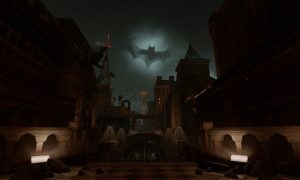November 2007, Call of Duty 4: Modern Warfare, Gaming Trend score 92%.
November 2008, Call of Duty: World at War, Gaming Trend score 92%.
November 2009, Call of Duty: Modern Warfare 2, Gaming Trend score 95%.
November 2010, Call of Duty: Black Ops, Gaming Trend score???
Like clockwork, every twelve months Activision rolls out a new title in the Call of Duty franchise and the public goes wild. Sales go through the roof, the media falls in love with the game, and all is good. Then another year goes by and a fresh Call of Duty game is released, beginning the cycle anew. While some pundits opined that the most recent Call of Duty, entitled “Black Ops”, could be the first to break this winning cycle with the departure from Activision of the leadership behind Modern Warfare (Infinity Ward), I’m here to tell you that this is not the case at all. After Treyarch’s success with World at War, Activision once again called upon the developer to step in and work their magic with the latest Call of Duty title, and it has every bit of polish and excitement we’ve come to expect from this series.
Developer concerns aside, the Call of Duty franchise is one that has never failed to succeed spectacularly, both critically and financially. This has created huge expectations for the title every year, and this time around is no different. So, does Treyarch have the ability to make everyone say “Infinity Who?” or will they leave players crying in their multiplayer maps? Let’s find out!
Character models in general have shown improvement, albeit these are minor tweaks for the most part. Greater variety in character appearance and customization make your avatar in multiplayer action feel more personalized, instead of just another generic “mercenary” clone. The customization doesn’t stop there of course, as with prior entries in the CoD series the weapon loadouts are where you can see the greatest difference between characters.
One of the most impressive graphical tweaks in Black Ops is the way the developers have modeled hit locations on the enemy. No longer are you stuck with every bullet impact (with the exception of the de rigueur head shot animations) being the same slow crumple of your opponent. Snap off a couple of quick pistol shots and hit your enemy in the shoulder and he’ll be spun around before going down. Aim low with a shotgun, striking your foe in the legs and he’ll be pitched forward as his legs are blown off. Grisly? Yes. Realistic and immersive? Absolutely. This is one of Black Ops’ biggest contributions to this round of the Call of Duty series, and the gritty realism that this game presents is extraordinary.
The level design in this series has always been top notch, but the improvements in Black Ops is more a result of the wide variety of locations that the game takes place in. Treyarch really put the extra effort into making the differing areas in the game feel realistic and alive and the results are spectacular. Whether it is Castro’s villa outside Havana, a Nazi cargo ship locked in a frozen ocean, or the sweltering jungles of Viet Nam, the environments come alive as you play your way through them. While the environments are not 100% destructible, enough of them are that players are forced to make realistic decisions on where to take cover. Don’t expect that wooden crate to stand up to concentrated enemy fire for long!
The Call of Duty series has never had any problem attracting big name Hollywood actors to provide the voices of the in-game characters, and Black Ops is no different. The single player campaign boasts the talents of such luminaries as Gary Oldman, Ed Harris, and Ice Cube among many others and the performances they turn in is rock solid.
For those that are not familiar with military hardware, let me assure you that the sound team at Treyarch did an excellent job of capturing the wide variety of distinctive sounds that the weapons in the game make in the real world. The popcorn-like sound of M16s in a firefight, the solid whack/thud of .50 cal rounds impacting around you, the roar of a M60, everything is right on. While this might not be as visceral an experience for a civilian as it is for a combat veteran, the effect on the gameplay is profound. Add in to all this Sean Murray’s solid and atmospheric score, and you’ve got a thoroughly engrossing single player experience.
The one place that the developers wisely chose not to make any changes is the game’s control scheme. Virtually unchanged over the last several titles, this is the ultimate example of “if it ain’t broke, don’t fix it”. Fully customizable if desired, the standard controls map the left shoulder button to aim down your sights (or zoom if sniping) and the right shoulder to fire your selected weapon. The left stick moves you around while the right stick controls where you look. I won’t bore you with breaking down the entire control scheme – suffice it to say that the controls are pretty much the default for every first person shooter out there and should immediately feel comfortable for anyone that’s spent time playing FPS games on consoles.
All these technical tweaks are all well and good, but they don’t mean a thing if the gameplay isn’t solid. Let’s start out with the single player experience. On the surface the premise of Black Ops sounds like a dream come true, playing through covert operations from the infamous Bay of Pigs, through the Tet offensive and the fall of Hue city and beyond.
The disparate times and locations are tied together rather loosely by a single covert operative. Without going into details that would ruin the surprises included in the campaign, let me just say that overall the story was a disappointment, especially considering the excellent single player experiences in the previous Call of Duty installments. Each of the levels work extremely well on their own; who wouldn’t want to try and assassinate Castro during the Bay of Pigs, or sabotage the Soviet space program at the Baikonur cosmodrome?
The problems appear when the writers attempted to tie all these scenarios together. The single operative and the mystery of Noble 6 plotline seems contrived and not at all believable, to the point where even the excellent voice acting can’t bring it back to the realm of possibility. Even though previous Call of Duty single player stories had fairly large gaps in logic, they were enjoyable and kept the player invested through sheer momentum of action. In Black Ops, this momentum is constantly being broken up by the story arc, leaving many players out in the cold as to what’s going on.
The other issue in the single player campaign is the inclusion of infrequent quicktime events during the missions. Quicktime events, or QTEs, are the gameplay mechanic of using timed button presses during interactive cutscenes to simulate actions. QTEs have been implemented successfully in many games, from God of War to Bayonetta to Dante’s Inferno, and when done right add to the gameplay experience. The first QTE that you encounter in Call of Duty: Black Ops is during the escape from Castro’s mansion in Cuba. At one point during your escape you jump into a car and are prompted to press the left trigger to put the car into reverse. In the other games mentioned above, you would have to press a series of buttons to simulate backing out and accelerating away to safety, but in Black Ops you just hit the left trigger and then cutscene takes over. Treyarch needed to either implement full-blown QTEs or not use them at all; this half-baked approach to this mechanic is annoying, breaks up the gameplay, and just doesn’t fit into this genre.
Let’s be honest though – the vast majority of the people that buy Black Ops are interested solely in the multiplayer options, and rightfully so. While the single player experience can be completed in a fairly short time, the amount of gameplay available in multiplayer can easily run into dozens and dozens of hours.
Salty veterans of first person shooters and the Call of Duty series in particular probably think they’ve seen it all when it comes to multiplayer game modes and options, but this time around Treyarch has implemented some surprising new changes that add more gameplay than ever. All the multiplayer standards are in place – there are a boatload of titles to achieve, weapons to unlock, and challenges to fulfill. In a major change to the game, players now earn “CoD” points as they play, and these points are used to purchase any of your upgrades.
CoD points can also be earned by purchasing contracts in multiplayer games. Each of the contracts has a CoD point cost, a goal, and a time limit in which to accomplish your goal. The most common types of contracts are to get a certain number of kills with a specific weapon, earning you a huge point bonus, usually four or five times the point cost to purchase the contract in the first place. This allows focused players to earn unlocks quite quickly, and provides an alternate path than just the usual playtime grind that we’ve seen previously. Treyarch has stated that the contracts will be dynamic, with new contracts being made available each week.
The fun doesn’t stop there though, as Treyarch has rolled out a new multiplayer match type called “Wager” matches. Wager matches are multiplayer contests that have a strictly defined set of rules. Players wager CoD points and the top three players at the end of the round split the wagered points based on their standing. Spread across five different modes of play, one of the most enjoyable is simply titled “Gun Game”. Players start out armed only with a pistol, but as soon as they get a kill they move up to the next weapon in line. This continues on through all twenty weapons – first player to get a single kill with all twenty wins the match. You have to be careful though, if you get knifed by another player you are moved to your previous weapon. Other modes, such as One in the Chamber (players get a pistol, a knife, and 1 round, each kill earns you another round) make for fantastic variety and will test the skills of even the most accomplished of shooters.
As everyone knows, the only thing better (and more socially acceptable) than killing hordes of Nazis, is killing hordes of zombies. Black Ops proves this truism by not only having Nazis you can mow down during the campaign, but by including three dedicated single player or cooperative zombie maps to work your way through. Only the first two (Kino Der Toten and Five) are true CoD maps, while Dead Ops Arcade is a top-down shooter more in the genre of Burn, Zombie Burn. Still plenty of fun, just a different style of gameplay.
While the single player campaign isn’t the compelling story that we’ve come to expect from the Call of Duty series, this is more due to players having been spoiled by superior content in previous titles. As expected, the campaign is short but does an excellent job of showcasing the various locations that the game takes place in, tying everything together in a neat package. The poor implementation of QTEs in the campaign is the only weakness in an otherwise solid effort.
Where the developer has really shined is in the beneficial changes they have made to the multiplayer experience. The addition of contracts and wager matches adds even more variety for FPS fans, above and beyond the plethora of options we’ve had available in the past. Whatever your gameplay preference is, Call of Duty: Black Ops has you covered and is a must-have title for any shooter fan.
Ron Burke is the Editor in Chief for Gaming Trend. Currently living in Fort Worth, Texas, Ron is an old-school gamer who enjoys CRPGs, action/adventure, platformers, music games, and has recently gotten into tabletop gaming.
Ron is also a fourth degree black belt, with a Master's rank in Matsumura Seito Shōrin-ryū, Moo Duk Kwan Tang Soo Do, Universal Tang Soo Do Alliance, and International Tang Soo Do Federation. He also holds ranks in several other styles in his search to be a well-rounded fighter.
Ron has been married to Gaming Trend Editor, Laura Burke, for 28 years. They have three dogs - Pazuzu (Irish Terrier), Atë, and Calliope (both Australian Kelpie/Pit Bull mixes), and an Axolotl named Dagon!

See below for our list of partners and affiliates:
























